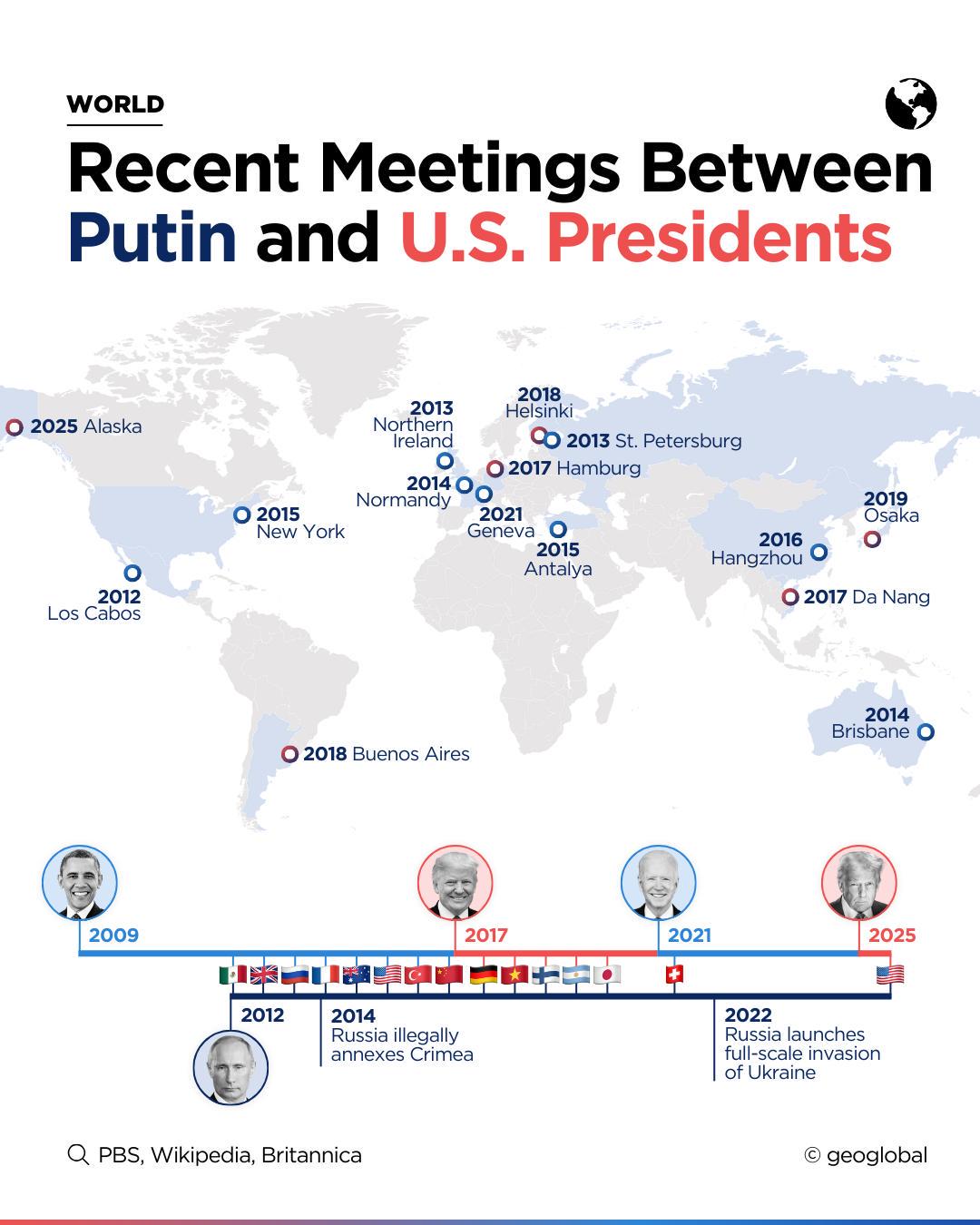Map of Meetings Between Putin and U.S. Presidents


Alex Cartwright
Senior Cartographer & GIS Specialist
Alex Cartwright is a renowned cartographer and geographic information systems specialist with over 15 years of experience in spatial analysis and data...
Geographic Analysis
What This Map Shows
The visualization titled "Every Meeting Between Putin and U.S. Presidents" provides a comprehensive look at the various occasions when Russian President Vladimir Putin has met with U.S. presidents throughout his time in power. This map highlights the locations and dates of these significant diplomatic encounters, underscoring the geopolitical landscape shaped by these meetings. Understanding the context and frequency of these interactions can help us appreciate the complex relationship between the United States and Russia, which has been marked by both cooperation and conflict.
Deep Dive into U.S.-Russia Diplomatic Relations
The history of U.S.-Russia relations is a tale of shifting dynamics, shaped by historical events, ideological differences, and the personal rapport between leaders. Since Putin first took office in 1999, he has engaged with various U.S. presidents, including Bill Clinton, George W. Bush, Barack Obama, Donald Trump, and Joe Biden. Each meeting has its significance and has contributed to the broader narrative of U.S.-Russia relations, which can be understood through a number of key themes.
Firstly, the meetings between U.S. presidents and Putin often revolve around security issues, especially concerning nuclear arms control and the fight against terrorism. For instance, the post-9/11 era saw a brief thaw in relations, with collaborations on counterterrorism efforts. Interestingly, the 2001 meeting between Putin and Bush in Slovenia marked a pivotal moment, as Bush famously claimed to have looked into Putin's eyes and found him trustworthy. This moment encapsulated the hope for a cooperative relationship at the time.
However, this trust was tested in subsequent years. The U.S. invasion of Iraq in 2003, for example, drew sharp criticism from Russia, leading to a deterioration in relations. Despite this, meetings continued, with Putin and Bush discussing strategies to manage tensions. The 2008 meeting in Sochi highlighted the ongoing complexities of their relationship, particularly regarding NATO expansion and the war in Georgia.
Barack Obama’s presidency brought a new approach, famously termed the “reset” of U.S.-Russia relations. The 2009 meeting in London emphasized diplomatic engagement, but the subsequent annexation of Crimea in 2014 by Russia marked a significant downturn. This event led to sanctions and a new level of animosity, reflected in the meetings that followed. The interactions became characterized more by conflict than cooperation, particularly during the Trump administration, where discussions often centered around election interference and cybersecurity threats.
As we analyze these meetings, it’s worth noting the changing geopolitical landscape, including the rise of China and ongoing tensions in the Middle East, which have also influenced U.S.-Russia dynamics. The recent summits between Biden and Putin underscore the continuation of this complex relationship, focusing on areas of mutual interest such as arms control, cybersecurity, and regional conflicts.
Regional Analysis
When examining the map, it’s essential to consider the geographical context of these meetings. The locations chosen for these diplomatic encounters often reflect strategic considerations. For instance, meetings in European cities like Helsinki and Geneva serve as neutral grounds, allowing both leaders to engage without the pressure of local politics. Interestingly, these locations often symbolize a historical connection to Cold War diplomacy.
On the other hand, meetings held in Russia, such as the ones in Sochi, emphasize Putin's domestic strength and his ability to showcase Russia on the world stage. The variance in locations also indicates the ebb and flow of relations; during warmer periods, such as the early 2000s, meetings were more frequent in neutral locations, whereas the more contentious periods saw leaders meeting in their respective capitals or at international summits.
In terms of frequency, the map clearly illustrates that the number of meetings has fluctuated significantly. The early 2000s saw a series of meetings as both sides sought to find common ground, while the subsequent years, particularly during the Obama administration and beyond, highlighted a stark reduction in face-to-face discussions. This decline reflects the increasing tensions and the complexities of modern diplomacy.
Significance and Impact
Understanding the meetings between Putin and U.S. presidents is crucial as it sheds light on the shifting dynamics of international relations. These meetings are not just formalities; they represent attempts to navigate global challenges ranging from nuclear proliferation to regional conflicts. The outcomes of these dialogues can have far-reaching implications, influencing global security, economic sanctions, and international alliances.
What's fascinating is how these engagements reflect broader trends in global politics. As the world becomes more multipolar with the rise of China and the resurgence of authoritarian regimes, the interactions between established powers like the U.S. and Russia hold significant implications for future geopolitics. The ongoing dialogue, despite its challenges, is vital for maintaining some level of stability in an increasingly complex world.
In conclusion, the map of every meeting between Putin and U.S. presidents serves as a vital historical record, illustrating not just the locations of these meetings, but also the evolving narrative of U.S.-Russia relations. As we move forward, understanding this history will be essential in navigating future diplomatic encounters and addressing the challenges that lie ahead.
Visualization Details
- Published
- August 16, 2025
- Views
- 100
Comments
Loading comments...